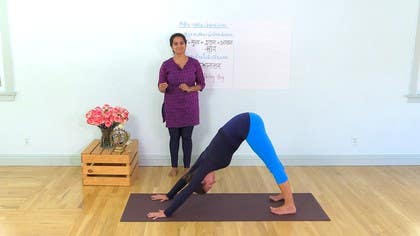Description
About This Video
Transcript
Read Full Transcript
Namaste dear friends, welcome again to the Sanskrit Yoga sessions. I am very happy to have with me Julia, my beautiful friend and we have been looking at the Sanskrit sounds. We also looked at the different body parts in Sanskrit and now we are going to see the Sanskrit words for the different asanas. So as we say them, do say along and we will enjoy the beauty of exploring the correctness of these sounds as much as we can because just as holding a right posture drives the energy in a particular manner and when you do the pranayama, the breath is moved in a particular manner, when you name the asanas correctly, the sound channelizes energy in a particular manner as well. So if you combine the posture with the breath and the correct name, imagine the alignment that your energies will experience.
So we will start with the first asana, the tadasana. Try saying that with me, tadasana. The word tadasana is composed of two words, tada meaning mountain plus asana. So the sound of it is tadasana, we will see what it looks like. So that is the transliteration of the sound tadasana of that word and you will notice there is a small dash and the dots that I have added in there.
That is to make the vowel long and the dot below indicates the position of that letter in your mouth. So it is the duh, tadasana. I will now show you what this asana looks like in the devanagari script. When you combine these two sounds, they become tadasana which is tadasana and in the devanagari script it is represented as tada sa na, there you go. The English equivalent of this pose that you are all already familiar with is the mountain pose.
Tada meaning mountain, there we are, tadasana and now we will request Julia to demonstrate this pose for us. Make sure you are standing completely straight. This pose is also in Sanskrit known as samastheti which means that it is a posture of balance. So the body is nice and straight, the arms are relaxed by the side, the vision is straight, you are looking straight ahead, the chin is parallel to the ground and you have a beautiful smile on your face. That's it.
I hope you enjoyed doing this asana and learning what it looks like and sounds like.
Mother Tongue: Pronouncing the Postures
Comments
You need to be a subscriber to post a comment.
Please Log In or Create an Account to start your free trial.










